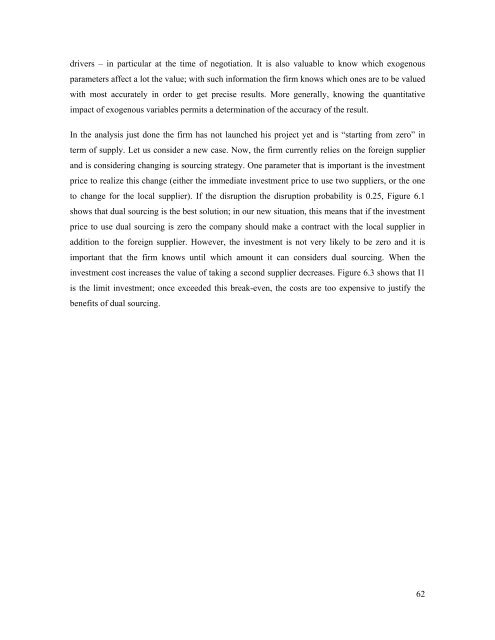Managing Risks of Supply-Chain Disruptions: Dual ... - CiteSeerX
Managing Risks of Supply-Chain Disruptions: Dual ... - CiteSeerX
Managing Risks of Supply-Chain Disruptions: Dual ... - CiteSeerX
You also want an ePaper? Increase the reach of your titles
YUMPU automatically turns print PDFs into web optimized ePapers that Google loves.
drivers – in particular at the time <strong>of</strong> negotiation. It is also valuable to know which exogenousparameters affect a lot the value; with such information the firm knows which ones are to be valuedwith most accurately in order to get precise results. More generally, knowing the quantitativeimpact <strong>of</strong> exogenous variables permits a determination <strong>of</strong> the accuracy <strong>of</strong> the result.In the analysis just done the firm has not launched his project yet and is “starting from zero” interm <strong>of</strong> supply. Let us consider a new case. Now, the firm currently relies on the foreign supplierand is considering changing is sourcing strategy. One parameter that is important is the investmentprice to realize this change (either the immediate investment price to use two suppliers, or the oneto change for the local supplier). If the disruption the disruption probability is 0.25, Figure 6.1shows that dual sourcing is the best solution; in our new situation, this means that if the investmentprice to use dual sourcing is zero the company should make a contract with the local supplier inaddition to the foreign supplier. However, the investment is not very likely to be zero and it isimportant that the firm knows until which amount it can considers dual sourcing. When theinvestment cost increases the value <strong>of</strong> taking a second supplier decreases. Figure 6.3 shows that I1is the limit investment; once exceeded this break-even, the costs are too expensive to justify thebenefits <strong>of</strong> dual sourcing.62
















